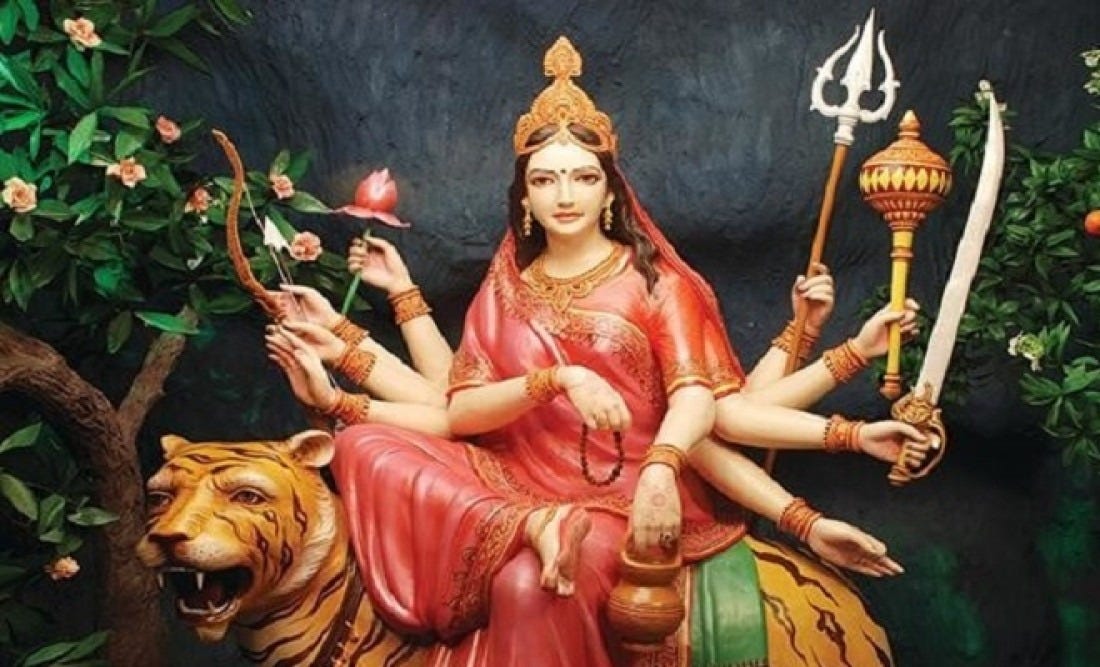CHANDRAGHANTA

Chandraghanta - Goddess of peace and power:
Chandraghanta is a prominent and revered goddess in Hindu mythology, celebrated during the Navratri festival, a nine-night festival dedicated to the worship of the divine feminine. In this essay, we will explore the significance, mythology, iconography and cultural relevance of Chandraghanta, delving deeper into the story and the teachings imparted to the devotees.
Introduction to Chandraghanta:
Chandraghanta is the third form of Goddess Durga and is known for her calm yet powerful presence. The word "Chandra" means moon, and "Ghanta" means bell. Hence, Chandraghanta translates to "moon-shaped bell". The iconography depicts her riding a lion, she has ten hands, each hand holding a different weapon and symbol of power, and she has a half moon on his forehead that looks like a bell.
Mythological origin:
To understand the significance of Chandraghanta, one has to go deep into the Hindu mythology and the epic of Devi Mahatmya. According to the Devi Mahatmya, a sacred text of the Markandeya Purana, Chandraghanta was born as the daughter of King Himalaya and Queen Mainavati. She was named Chandraghanta because of the unique crescent-shaped bell adorning her forehead.
Chandraghanta image:
Chandraghanta iconography has deep symbolism and each element has a specific meaning.
Riding a lion:
Chandraghanta is often depicted riding a lion, symbolizing fearlessness and courage. The lion also represents the overcoming of all obstacles and the victory of good over evil.
Ten Arms:
She has ten arms, each holding a different weapon or symbol of power. These arms represent his immense power and ability to protect his devotees. Some of the items he possesses include trident, sword, bow, arrow and lotus.
Half Moon Bell:
The half moon on her forehead is shaped like a bell and symbolizes the beauty and grace of the Goddess. It reminds us of the importance of balance and peace even in the face of challenges.
Rosary:
She holds a rosary in one hand, symbolizing the importance of devotion and spiritual discipline in one's life.
Dhyana Mudra:
In some depictions, Chandraghanta is shown in Dhyana Mudra, which shows the meditative and peaceful aspect of the goddess.
Japa Mala:
She holds a japa mala (prayer beads) in one hand, emphasizing the importance of meditation and spiritual practices.
Golden Armor:
She is often adorned with golden jewelery and armour, representing her royal and majestic nature.
Third Eye:
Like many other forms of the goddess, Chandraghanta has a third eye on her forehead, symbolizing her all-seeing and intuitive nature.
Importance of Chandraghanta:
Chandraghanta is a goddess of utmost importance and her worship brings many teachings and blessings to her devotees.
Courage and fearlessness:
Her association with the lion and decision to marry Lord Shiva symbolizes the importance of courage and fearlessness in facing the challenges of life. She teaches us to be courageous and steadfast in our actions.
Balance and Harmony:
The crescent-shaped bell on her forehead reminds us of the importance of balance and peace. She teaches us that true strength comes from maintaining inner peace and balance.
Spiritual Discipline:
The rosary and chanting beads in their hands emphasize the importance of spiritual discipline and meditation in one's life. She encourages her devotees for their spiritual development.
Protection:
Chandraghanta is also the protector of her devotees. Her ten arms represent her readiness to protect her worshipers from harm and evil influences.
Union of Opposites:
Her marriage with Lord Shiva symbolizes the union of masculine and feminine energies. She reminds us that true strength emerges from the harmonious integration of opposing forces.
worship and rituals:
Chandraghanta is worshiped on the third day of Navratri, one of the most important festivals in Hinduism. Devotees offer prayers, flowers, incense and special sweets to seek his blessings. During this period, fasting, meditation and chanting of mantras dedicated to her are also common practices.
cultural relevance:
The importance of Chandraghanta goes beyond the scope of religious worship. She represents the embodiment of feminine strength and power. Her story and characteristics inspire women and men alike to embrace their inner strength and face life's challenges with courage. She is a symbol of female empowerment and a testament to the idea that women can be both cool and powerful, gentle and fearless.
In popular culture, Chandraghanta has been depicted in various forms of art, literature, and media. Her image is often used to convey a sense of feminine strength and beauty.According to religious scriptures, you can chant these mantras to please Mother Chandraghanta.
Namastesyaye Namastesyaye Namastesyaye Namo Namah
Rahasyam Shrunu Vakshyaami Shaiveshi Kamlanane.
Shri Chandraghantasya Kavacham Sarvasiddhidayakam.



